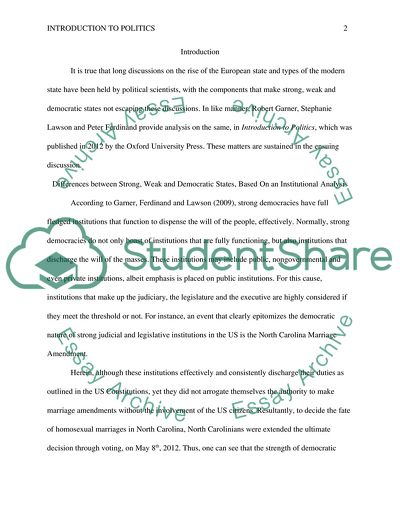Cite this document
(Introduction to Politics - Differences between Strong, Weak, and Democ Term Paper, n.d.)
Introduction to Politics - Differences between Strong, Weak, and Democ Term Paper. Retrieved from https://studentshare.org/politics/1613935-political-scientists-engage-in-long-discussions-on-the-rise-of-the-european-state-and-types-of-the-modern-state-please-analyze-the-differences-between-the-strong-weak-and-democratic-states-based-on-an-institutional-analysis-is-the-state-entering-a
Introduction to Politics - Differences between Strong, Weak, and Democ Term Paper. Retrieved from https://studentshare.org/politics/1613935-political-scientists-engage-in-long-discussions-on-the-rise-of-the-european-state-and-types-of-the-modern-state-please-analyze-the-differences-between-the-strong-weak-and-democratic-states-based-on-an-institutional-analysis-is-the-state-entering-a
(Introduction to Politics - Differences Between Strong, Weak, and Democ Term Paper)
Introduction to Politics - Differences Between Strong, Weak, and Democ Term Paper. https://studentshare.org/politics/1613935-political-scientists-engage-in-long-discussions-on-the-rise-of-the-european-state-and-types-of-the-modern-state-please-analyze-the-differences-between-the-strong-weak-and-democratic-states-based-on-an-institutional-analysis-is-the-state-entering-a.
Introduction to Politics - Differences Between Strong, Weak, and Democ Term Paper. https://studentshare.org/politics/1613935-political-scientists-engage-in-long-discussions-on-the-rise-of-the-european-state-and-types-of-the-modern-state-please-analyze-the-differences-between-the-strong-weak-and-democratic-states-based-on-an-institutional-analysis-is-the-state-entering-a.
“Introduction to Politics - Differences Between Strong, Weak, and Democ Term Paper”, n.d. https://studentshare.org/politics/1613935-political-scientists-engage-in-long-discussions-on-the-rise-of-the-european-state-and-types-of-the-modern-state-please-analyze-the-differences-between-the-strong-weak-and-democratic-states-based-on-an-institutional-analysis-is-the-state-entering-a.


